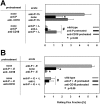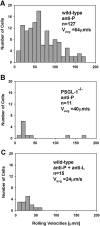P-selectin glycoprotein ligand-1 mediates L-selectin-dependent leukocyte rolling in venules
- PMID: 12756271
- PMCID: PMC2193782
- DOI: 10.1084/jem.20021854
P-selectin glycoprotein ligand-1 mediates L-selectin-dependent leukocyte rolling in venules
Abstract
Leukocyte rolling in postcapillary venules of inflamed tissues is reduced in L-selectin-deficient mice and mice treated with L-selectin blocking antibodies, but the glycoprotein ligand for L-selectin in inflamed venules is unknown. Here, we show that L-selectin-dependent rolling after P-selectin blockade is completely absent in P-selectin glycoprotein ligand-1 (PSGL-1)-/- mice or wild-type mice treated with a PSGL-1 blocking monoclonal antibody. Immunohistochemistry and flow cytometry failed to show PSGL-1 expression on resting or inflamed endothelium or on platelets. To investigate whether leukocyte-expressed PSGL-1 is mediating L-selectin-dependent rolling, we reconstituted lethally irradiated wild-type mice with PSGL-1-/- bone marrow cells. These chimeric mice showed no L-selectin-dependent rolling, suggesting that leukocyte-expressed PSGL-1 mediates L-selectin-dependent rolling. Frame-to-frame video analysis of L-selectin-dependent rolling in wild-type mice showed that the majority of observed L-selectin-dependent leukocyte rolling was between free flowing leukocytes and already adherent leukocytes or possibly leukocyte fragments, followed by E-selectin-dependent leukocyte rolling along the endothelium. Leukocyte rolling was significantly slower for leukocyte-endothelial than leukocyte-leukocyte interactions. We conclude that leukocyte-expressed PSGL-1 serves as the main L-selectin ligand in inflamed postcapillary venules. L-selectin binding to PSGL-1 initiates tethering events that enable L-selectin-independent leukocyte-endothelial interactions. These findings provide a molecular mechanism for the inflammatory defects seen in L-selectin-deficient mice.
Figures




References
-
- Butcher, E.C. 1991. Leukocyte-endothelial cell recognition - Three (or more) steps to specificity and diversity. Cell. 67:1033–1036. - PubMed
-
- Kunkel, E.J., J.L. Dunne, and K. Ley. 2000. Leukocyte arrest during cytokine-dependent inflammation in vivo. J. Immunol. 164:3301–3308. - PubMed
-
- Kansas, G.S. 1996. Selectins and their ligands: current concepts and controversies. Blood. 88:3259–3287. - PubMed
-
- Vestweber, D., and J.E. Blanks. 1999. Mechanisms that regulate the function of the selectins and their ligands. Physiol. Rev. 79:181–213. - PubMed
Publication types
MeSH terms
Substances
Grants and funding
LinkOut - more resources
Full Text Sources
Other Literature Sources

